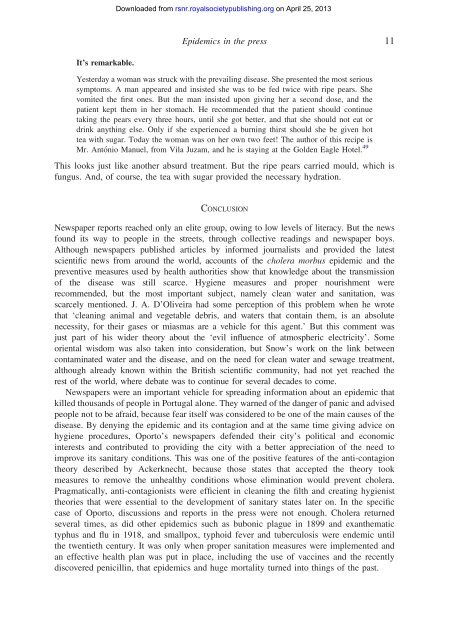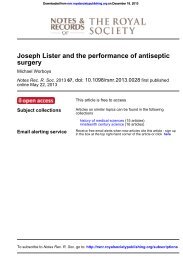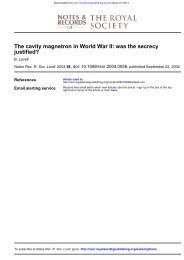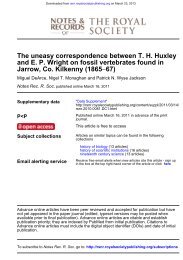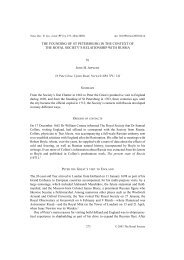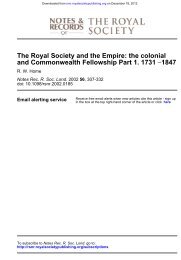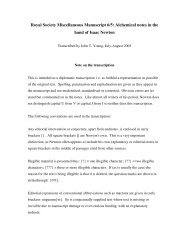THE PORTUGUESE CHOLERA MORBUS EPIDEMIC OF 1853–56 ...
THE PORTUGUESE CHOLERA MORBUS EPIDEMIC OF 1853–56 ...
THE PORTUGUESE CHOLERA MORBUS EPIDEMIC OF 1853–56 ...
Create successful ePaper yourself
Turn your PDF publications into a flip-book with our unique Google optimized e-Paper software.
It’s remarkable.<br />
Downloaded from<br />
rsnr.royalsocietypublishing.org on April 25, 2013<br />
Epidemics in the press 11<br />
Yesterday a woman was struck with the prevailing disease. She presented the most serious<br />
symptoms. A man appeared and insisted she was to be fed twice with ripe pears. She<br />
vomited the first ones. But the man insisted upon giving her a second dose, and the<br />
patient kept them in her stomach. He recommended that the patient should continue<br />
taking the pears every three hours, until she got better, and that she should not eat or<br />
drink anything else. Only if she experienced a burning thirst should she be given hot<br />
tea with sugar. Today the woman was on her own two feet! The author of this recipe is<br />
Mr. António Manuel, from Vila Juzam, and he is staying at the Golden Eagle Hotel. 49<br />
This looks just like another absurd treatment. But the ripe pears carried mould, which is<br />
fungus. And, of course, the tea with sugar provided the necessary hydration.<br />
CONCLUSION<br />
Newspaper reports reached only an elite group, owing to low levels of literacy. But the news<br />
found its way to people in the streets, through collective readings and newspaper boys.<br />
Although newspapers published articles by informed journalists and provided the latest<br />
scientific news from around the world, accounts of the cholera morbus epidemic and the<br />
preventive measures used by health authorities show that knowledge about the transmission<br />
of the disease was still scarce. Hygiene measures and proper nourishment were<br />
recommended, but the most important subject, namely clean water and sanitation, was<br />
scarcely mentioned. J. A. D’Oliveira had some perception of this problem when he wrote<br />
that ‘cleaning animal and vegetable debris, and waters that contain them, is an absolute<br />
necessity, for their gases or miasmas are a vehicle for this agent.’ But this comment was<br />
just part of his wider theory about the ‘evil influence of atmospheric electricity’. Some<br />
oriental wisdom was also taken into consideration, but Snow’s work on the link between<br />
contaminated water and the disease, and on the need for clean water and sewage treatment,<br />
although already known within the British scientific community, had not yet reached the<br />
rest of the world, where debate was to continue for several decades to come.<br />
Newspapers were an important vehicle for spreading information about an epidemic that<br />
killed thousands of people in Portugal alone. They warned of the danger of panic and advised<br />
people not to be afraid, because fear itself was considered to be one of the main causes of the<br />
disease. By denying the epidemic and its contagion and at the same time giving advice on<br />
hygiene procedures, Oporto’s newspapers defended their city’s political and economic<br />
interests and contributed to providing the city with a better appreciation of the need to<br />
improve its sanitary conditions. This was one of the positive features of the anti-contagion<br />
theory described by Ackerknecht, because those states that accepted the theory took<br />
measures to remove the unhealthy conditions whose elimination would prevent cholera.<br />
Pragmatically, anti-contagionists were efficient in cleaning the filth and creating hygienist<br />
theories that were essential to the development of sanitary states later on. In the specific<br />
case of Oporto, discussions and reports in the press were not enough. Cholera returned<br />
several times, as did other epidemics such as bubonic plague in 1899 and exanthematic<br />
typhus and flu in 1918, and smallpox, typhoid fever and tuberculosis were endemic until<br />
the twentieth century. It was only when proper sanitation measures were implemented and<br />
an effective health plan was put in place, including the use of vaccines and the recently<br />
discovered penicillin, that epidemics and huge mortality turned into things of the past.


